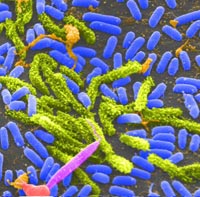Bacterial Water Pollution

 Symptoms of waterborne diseases may include gastrointestinal illnesses such as severe diarrhea, nausea, and possibly jaundice as well as headaches and fatigue. It is important to note, however, that these symptoms are not associated only with disease-causing organisms in drinking water. They may also be caused by a number of other factors. In addition, not all people will be affected to the same degree; young children and the elderly are usually more susceptible.
Symptoms of waterborne diseases may include gastrointestinal illnesses such as severe diarrhea, nausea, and possibly jaundice as well as headaches and fatigue. It is important to note, however, that these symptoms are not associated only with disease-causing organisms in drinking water. They may also be caused by a number of other factors. In addition, not all people will be affected to the same degree; young children and the elderly are usually more susceptible.
When monitoring for bacterial pollution, two closely related bacteria groups have been used for decades as “indicator organisms.” Fecal coliform and E. coli bacteria provide an indication of the possible presence of pathogens. E. coli is a sub-group of fecal coliform, and is virtually always present in water along with fecal coliform. Protozoa, microorganisms such as Giardia and Cryptosporidia, may also be present in animal waste and can be disease-causing in humans.
Factors Affecting Bacteria
As with many water pollutants, the behavior of fecal coliform and E. coli in the environment is complex. Factors affecting bacteria levels include seasonal weather, stream flow, water temperature, distance from pollution sources, livestock management practices, wildlife activity, age of fecal material, sewage overflows, and rainfall. In addition, bacteria in stream sediments can survive for extended periods and even grow. Despite the potential for growth of bacteria in stream sediments, die-off is still the dominant process.
It is advisable for all homeowners to have their water tested and to take the necessary steps to protect their family from these harmful effects.
Ready to Get Started?
To learn more about our Environmental Testing Services
click below, or contact us at (509) 720-0190
